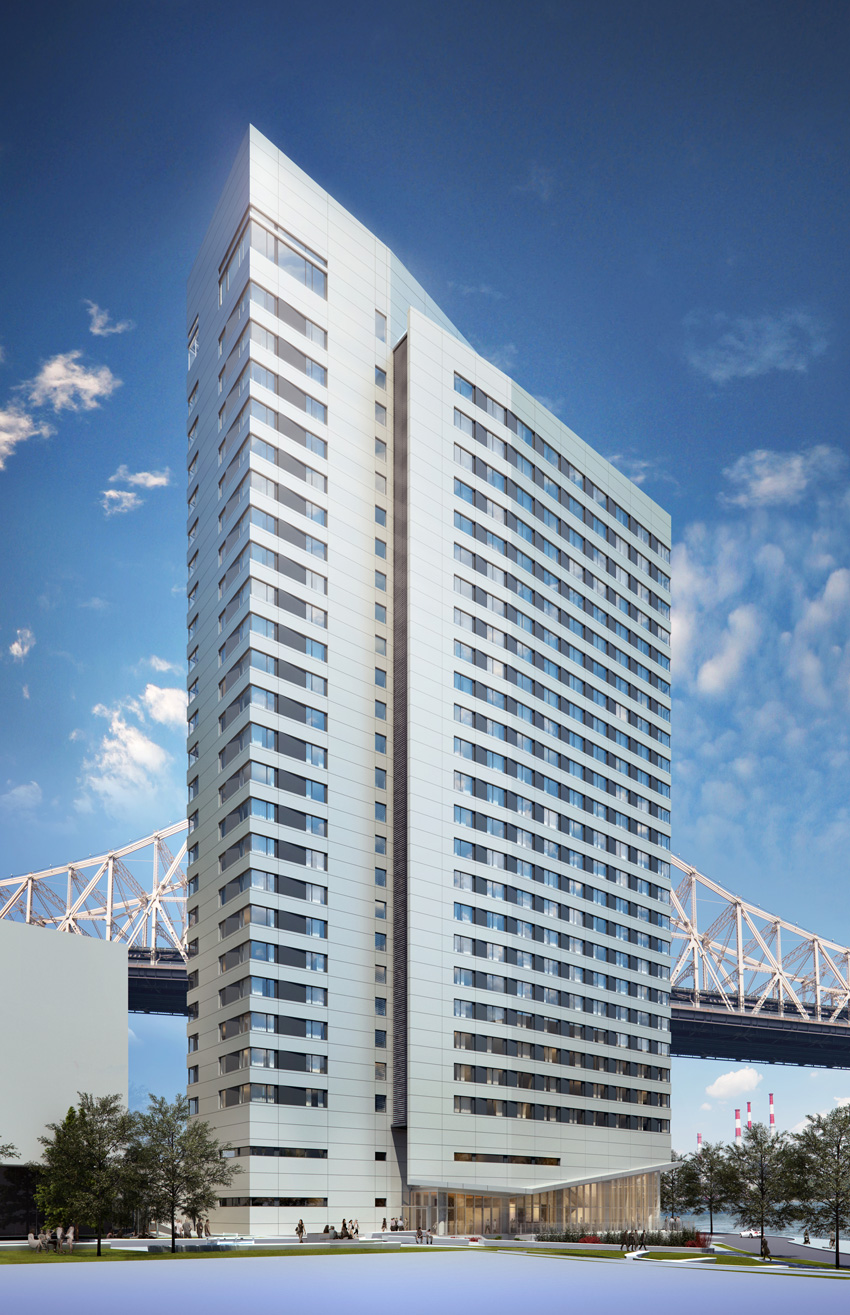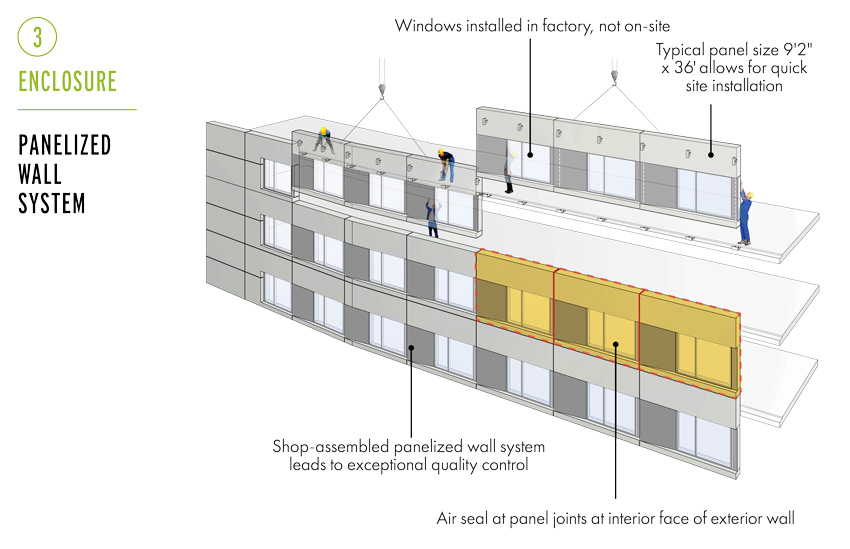Actively Pursuing Passivhaus Enclosures
Passivhaus and Curtain Wall
Debunking the misperception that Passivhaus buildings are dark spaces with little glass, architects aren’t hesitating to include curtain wall systems in these projects.
Unlike small glazing panels, the larger panels that are incorporated into curtain wall systems lose less heat at the frames and edges. Compared to window walls, curtain walls deliver better airtightness, less thermal bridging, reduced framing systems, and increased sight lines. “If the curtain wall is prefabricated off-site, a portion of the insulation and air-sealing aspects of the Passivhaus envelope can be completed in very controlled conditions, in a factory setting away from cold or wet conditions,” says Stas Zakrzewski, AIA, LEED AP, a Certified Passive House Consultant and principal of ZH Architects.
For the Passivhaus-certified, 18,000-square-foot Kiln Apartments project in Portland, Oregon, GBD Architects specified wood stud framing with a liquid-applied membrane, exterior insulation, and very high-performing windows. However, constructing the building was very challenging, reports Agustin Enriquez V, a principal of GBD. In retrospect, “a curtain wall facade system would have sped up construction dramatically, and in our experience with high-rise buildings, the quality control would have been much higher,” he explains.
With unitized curtain walls, Enriquez points out that the joints are very consistent between units. “Solving the jamb, head, and sill at one time, with factory quality control, installation is much easier and can eliminate a lot of the installation challenges we have experienced,” he says.
Curtain walls also integrate well with double-skin facades. With an exterior glazed appearance and inner wall, requiring less glass, these double-wall systems—popular in Europe—offer glass facade aesthetics with better energy performance. While U.S. designers have experimented with double-skin designs, the technology has yet to catch on widely here. But with more domestic research and development, designers anticipate this will start to change.
In any case, a curtain wall’s modern appearance and expansive glass aesthetics make it an appealing choice for commercial facilities. That said, building orientation and wall-to-window ratio must be carefully calculated to maximize its efficiency.
“If one entirely clads a building with a uniform curtain wall glazing system or doesn’t think about the orientation of the glazing with regard to the winter and summer sun paths, one can end up putting transparent glazing where it will work against the building in space conditioning the envelope, rather than working for the building, and this could make it very difficult to meet the Passivhaus standard,” Snyder says.
Designers must also consider internal heat gain, the potential need for shading devices, and thermal loss from the curtain wall frames.
Regarding the latter, Judah sees research and development opportunities for curtain wall manufacturers to design higher-performing, thermally broken frames, spandrels, and other components.
One way that Handel Architects addressed this issue for the design of a 26-story academic residence tower for Cornell Tech’s new Roosevelt Island campus in Manhattan was the specification of a mega panel. As opposed to a curtain wall, the panel-to-panel joints—which are the weakest thermal part of a building’s facade—are minimized, Moelis says. Whereas a typical curtain wall utilizes 4-foot-wide panels, the mega-panel system at Cornell Tech is approximately 36 feet wide.

Image courtesy of Handel Architects
When completed, this 26-story academic residence tower for Cornell Tech’s new Roosevelt Island campus is anticipated to be the largest Passivhaus residential building in the world.
Furthermore, the introduction of thermal breaks in panel structure and exterior finish support clips supports increased R-values. In fact, the thermally broken windows deliver an excellent U-value of 0.17, which is drastically lower than the 0.44 to 0.46 R-value range for typical windows. This hybrid mega-panel technology also combines the features of a wall and a window where individual panels are not structurally dependent on the adjacent panels.

Image courtesy of Handel Architects
Specifying a mega-panel system in leui of a curtain wall, larger panel sizes and fewer joints deliver better thermal insulation for the Cornell Tech residence tower.
While continuous insulation (ci) has been a bonus, not to mention the fact that the ci completely passes by slab edges because the panel is hung off of the building, at the same time, the project’s Passive House consultant Lois Arena, PE, CPHD, senior mechanical engineer for Steven Winter Associates, admits that attaching the mega panels to the frame has created challenging thermal bridging issues. As she explains in NAPHN’s Passive House Accelerates, “to keep those panels securely attached to the frame, there are 123 anchors on each floor, and each one of those anchors has to be insulated and air sealed.”

Image courtesy of Handel Architects
Carefully detailed air sealing will help Cornell Tech achieve a rigorous Passivhaus airtight envelope standard of 0.6ACH@50pa.
Of course, curtain walls’ large expanses of glass enable larger solar heat gains than smaller punched windows. Carefully integrated solar shading can help address this issue, while simultaneously serving as a design feature. However, in order to attach the shading device directly to the curtain wall, Piselli explains that a structural connection has to be made, thereby creating a technical challenge to maintaining the thermally broken frame.
“The most challenging aspect at the moment is limited ‘off-the-shelf’ thermally broken Passive House-level curtain wall systems that are tested to U.S. standards,” Zakrzewski says.
While the technology is available in Europe, there’s the chicken-and-egg issue of market demand. “With the assorted certifications and costs, there is not yet much incentive to bring these products to the United States,” Judah explains.
“There have to be ways for United States companies to partner with European manufacturers to help bring these products to the market here,” she continues. “The technology is out there; it’s just a question of access and competitive pricing.”Another challenge, says Enriquez, is the transition between the curtain wall units and roof or soffit. While difficult on any project, the issue of figuring out how to best seal and thermally isolate those joints is even more critical when attempting to meet Passivhaus standards.









